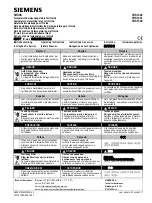
BE1-51/27C Controls and Indicators
2-3
Table 2-1. Controls and Indicators - Continued
Letter
Control or Indicator
Function or Indicator
K
PUSH-TO-ENERGIZE OUT-
PUT
Pushbutton
Actuation of this function is by a thin non-conducting rod
(
do not use a screwdriver) through a hole in the front
panel. This allows the output relays to be manually
energized for testing of the external trip circuit(s).
ELEMENT
targets, where supplied, are not operated by
this control.
L
TIMING
Indicator
LEDs illuminate when the preset overcurrent pickup point
is reached and exceeded.
M
TIME DIAL
Selector
Determines the time delay between sensing of the
overcurrent condition and the closing of the output relay.
Refer to Section 1 and Table 2-3 for curve selection
information.
N
TAP CAL
Control
A single turn potentiometer provides adjustment of the
phase overcurrent pickup point between the selected tap
setting and the next lower tap setting.
O
INST 1
Control (Options 1-1
and 1-2 Only)
**
A four turn potentiometer provides adjustment of the front
panel
INST 1
trip setting over the range of 1 to 40 times
the selected phase time overcurrent pickup (TAP) value.
P
VOLTAGE INHIBIT A, B, C*
ADJ
A four turn potentiometer provides continuous adjustment
over a range of 40 to 120 Vac of the sensed input front
panel
VOLTAGE INHIBIT
level.
Q
VOLTAGE INHIBIT A, B, C*
Indicator(s)
LEDs illuminate when the sensed input voltage level
exceeds the front panel pre-set
VOLTAGE INHIBIT
level.
R
INST 1 NEUTRAL
Control
(Options 1-1 and 1-2 Only)
**
A four turn potentiometer provides adjustment of the front
panel
INST 1 NEUTRAL
trip setting over the range of 1 to
40 times the selected neutral time overcurrent pickup
(TAP) value.
Not
Shown
INST 2
Control (Option 1-2
Only)
**
A four turn potentiometer provides adjustment of the front
panel
INST 2
trip setting of the range of 1 to 40 times the
selected phase time overcurrent pickup (TAP) value.
Not
Shown
N/T (Normal/Test) Switch S1
This switch is mounted internally on the logic board.
Switch S1 provides stored built-in-test (BIT) programs
used during troubleshooting, repair, and calibration. This
switch is not used during normal relay setting or
operational testing.
LEGEND
*
The number of phases and neutral sensed by the relay is defined by the sensing input type (See
the Style Identification Chart, Figure 1-1).
**
This Instantaneous overcurrent sensing circuit detects levels that are multiples of the level
selected for the time overcurrent sensing circuit. Any change of the tap selector or calibration
(CAL) controls will cause a directly proportional change of the instantaneous overcurrent Levels.
Summary of Contents for BE-51/27C
Page 1: ...0 1 2 3 4 5 67869 ABC DEF G 6H II GGJ KL M DEF DEK...
Page 16: ...BE1 51 27C Controls and Indicators 2 2 Figure 2 1 Location of Controls and Indicators...
Page 20: ...BE1 51 27C Controls and Indicators 2 6...
Page 22: ...BE1 51 27C Functional Description 3 2 Figure 3 2 Functional Block Diagram...
Page 32: ...BE1 51 27C Installation 4 7 Figure 4 10 Typical Internal Diagram Sensing Input Type L...
















































